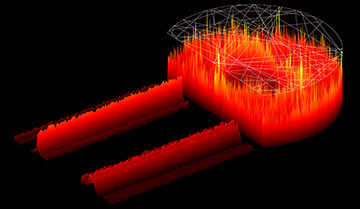
The D-shaped cavity produces quantum chaos within the cavity, resulting in a more stable laser. [Image: Stefan Bittner/Yale University]
Fighting fire with fire is a tried-and-true tactic in protecting forests—and a lesson in laser physics as well. An international team of scientists has learned how to combat instabilities in a high-powered laser by introducing additional chaos into the system (Science, doi:10.1126/science.aas9437).
Taming instabilities with geometry
The propagation of self-organized filaments within a lasing medium can make the laser pulse erratically, lower its output power or alter its beam profile. Previous work in taming these instabilities involved reductions in the number of lasing modes or applying external signals. Those strategies work with semiconductor lasers of moderate power, but start to fail at the higher powers demanded by laser surgery, projection displays, lidar and other modern applications.
A group led by two OSA Fellows, Hui Cao of Yale University, USA, and Ortwin Hess of Imperial College London, U.K., proposes to suppress the nonlinear processes that generate filaments by adding a dash of quantum chaos to the mix. While semiconductor lasers typically contain a cavity of some type of cubic or rectangular shape, with parallel mirrors at each end, the researchers designed and built a D-shaped cavity with mirrors around its asymmetric sides. The unusual geometry generates fine-grained chaotic standing waves in all directions across the cavity.
Wave-chaotic design
This quantum chaos acts on a much smaller scale than the wavelength of the laser light, so it suppresses the formation of larger instabilities such as filaments. The researchers tested their proposal on D-cavity lasers fabricated by multiple methods—photolithography, reactive-ion etching and chemical etching—and got similar results.
The researchers suggest that the wave-chaotic design may be applicable to other types of lasers, from vertical-cavity surface-emitting lasers (VCSELs) to multimode fiber lasers, that also exhibit instabilities at higher powers. These lasers could be stabilized by changing the shape of the cavity (in the case of VCSELs) or of the fiber cross section (in the case of fiber lasers).
Cao and her group at Yale performed the main experiments, while Hess and his Imperial College colleagues contributed the theoretical analysis. Researchers from Nanyang Technological University in Singapore performed the nanofabrication of the experimental laser components.
